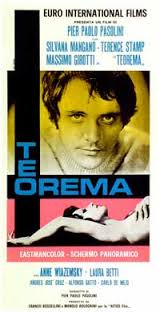
TEOREMA
1968, Italy, 103 minutes, Colour/Black and white.
Terence Stamp, Silvana Mangano, Massimo Girotti, Anne Wiezamsky, Laura Betti.
Directed by Pier Paolo Pasolini.
Teorema is certainly a puzzle. A theorem offers a saying of truth in a formula which is abstracted from reality and made a principle for further calculations. This film certainly seems to be making statements. There are geometrical patterns in the relationships. But one wonders what is solved. Many critics dismissed the film as pretentiously boring and a solemn "put-on", others were very impressed with its strange exploration of relationships, the inadequacies of self-images and the changes in way of life wrought by the loving intervention of a stranger. And who was the stranger - A Christ-figure or Devil-figure. The fact that sexuality was the mode of communication chosen by Pasolini to symbolise the relationship that changed people is certainly a complicating factor. So are recurring texts from the book of Exodus and the prophet Jeremiah. But theorems are to be worked out, understood and applied. Teorema, of course, is a must for those who like Pasolini's work (Accattone, Gospel According to Matthew, Oedipus The King). After Teorema, Pasolini made Medea, The Decameron, The Canterbury Tales, Arabian Nights, which have also made the critics praise and wonder.
When Teorema was awarded the OCIC, Catholic award at the Festival of Venice in 1969, Vatican reaction was strongly against it and Pasolini returned the award he had won in 1964 for his Gospel according to Matthew.
1. What was the significance of the title - a simple geometrical term applied to this family situation?
2. A mystery name: "theos" is Greek for "God"? How did the film quickly and visually establish each character?
3. What was the impact of the factory sequence - use of colour, documentary style? The question of strikes and capitalism as connected with this film?
4. The question of social change was immediately raised and a man confronted by social reform (in the industrial north of Italy, Turin).
5. What was the bearing of this in the film and on the people involved in this film? What was the significance of the Exodus symbol - the text, the desert, purification; the visualising of the desert, the monochrome sands and wind?
6. Was the visit of the young man made credible in terms of realism? Did it matter who he was? Some see him as a Christ-figure (changing peoples' lives and saving them from themselves); others see him as a figure of evil, depraving and withdrawing people from life. What did Terence Stamp's acting suggest? How did the young man fit into the home? How was this visually shown? Effectively? His contact with each of the characters, their reactions, the overall effect, the particularly sexual relationships and the significance of this? The mid: service. The daughter: seemingly normal relationship, The son: sharing the room and interest. The mother: a guest. The father: his feet. How important were these experiences for each concerned; how partial? What aspects of their personalities and needs did they represent? What effect did the experiences have on the young man? Was he too enigmatic? How important were the young man's reactions for the whole film? what was the significance of the effect of the experience on each? The maid: fulfilment, her leaving. her going to the people, the levitation (how important are the expected styles of Southern Italian sanctity here). fasting, ecstasy; did Pasolini mean her to be a saint? The mother: awakening of desire, self-seeking, picking up men - how fulfilling, how brutal? Her confession - was this a sinning to discover meaning through sensuality and forgiveness through sinning (or is this too far-fetched?) The daughter: the trance - self-centred. non-productive. The son: going away. growth in self-understanding, self-disgust, dissatisfaction with his creative work the significance of urinating on the paintings, where had he arrived? The father: change in outlook as regards the factory, his life-values, his public stripping of himself and going out into the Exodus desert.
8. What was the significance of the Jeremiah repentance text?
9. Comment on the didactic, schematic (geometrical) structure of the film and its overall effect, repetition of the chorus theme.
10. Pasolini is a Marxist - has this any relevance to the film? (He is a humanist - with interests in Christianity).
11. Is the film too symbolic; does it communicate effectively? Is it a worthwhile film?